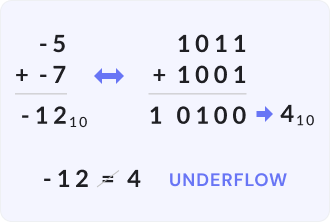Arithmetic Underflow Definition

Arithmetic underflow — when the result of a floating-point operation gets so close to zero that the order of the number is off the digit grid. In part, underflow can be seen as a negative overflow of the exponent of the floating point value.
An arithmetic underflow occurs when the true value of the floating point operation is smaller in magnitude (but not in direction) than the minimum one that could be represented as a normal floating point value in the target type.
An underflow can produce any subset of these effects: set a “sticky” status bit (the status bit remains set or unchanged until it is explicitly cleared), raise an exception, generate an interrupt at the hardware level.
Usually, it only gives 0, but sometimes it would be good to separate non-zero numbers and zero more distinctly. For example, in the case when the result is used after as a divisor, it will help to avoid division by 0.